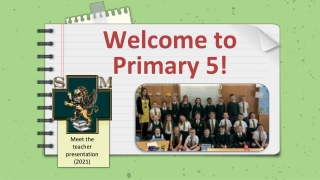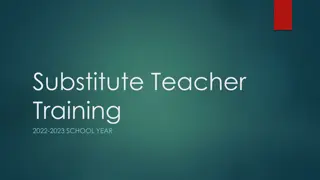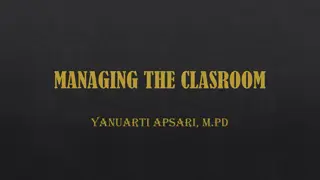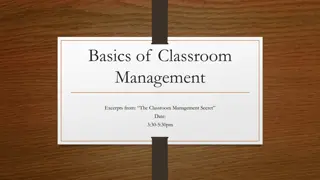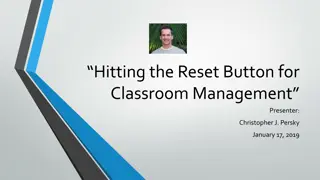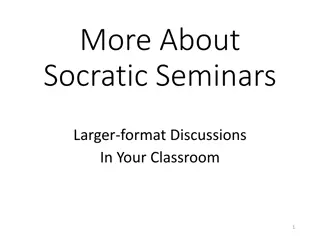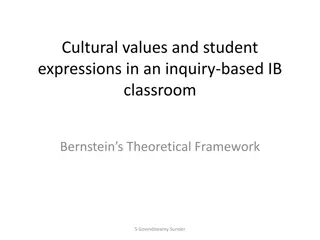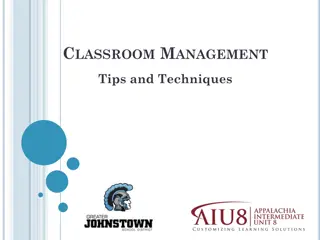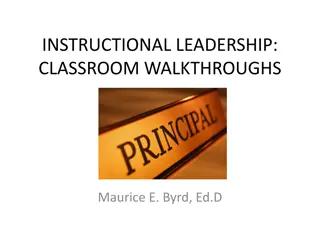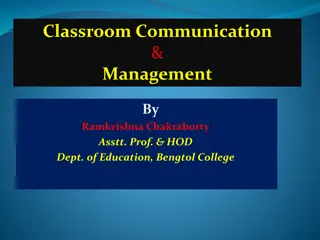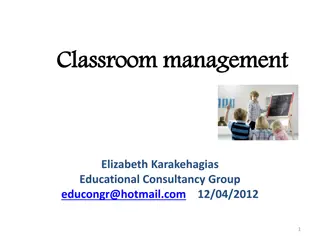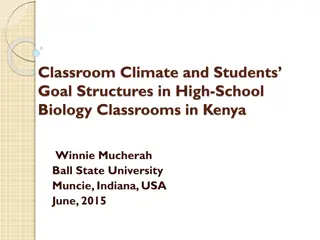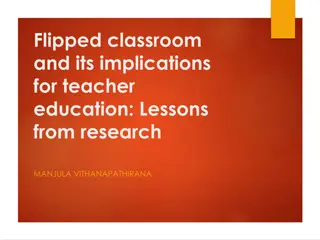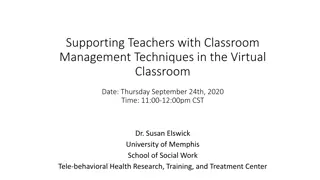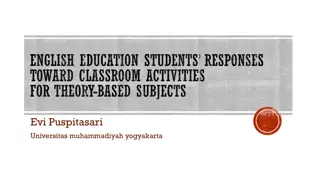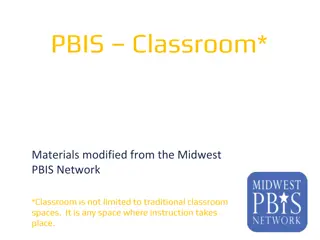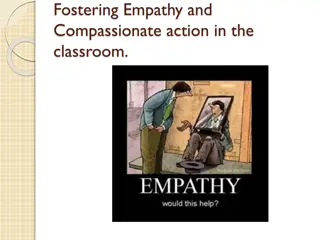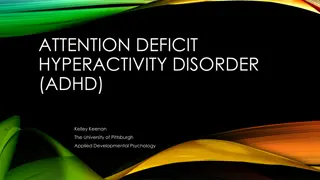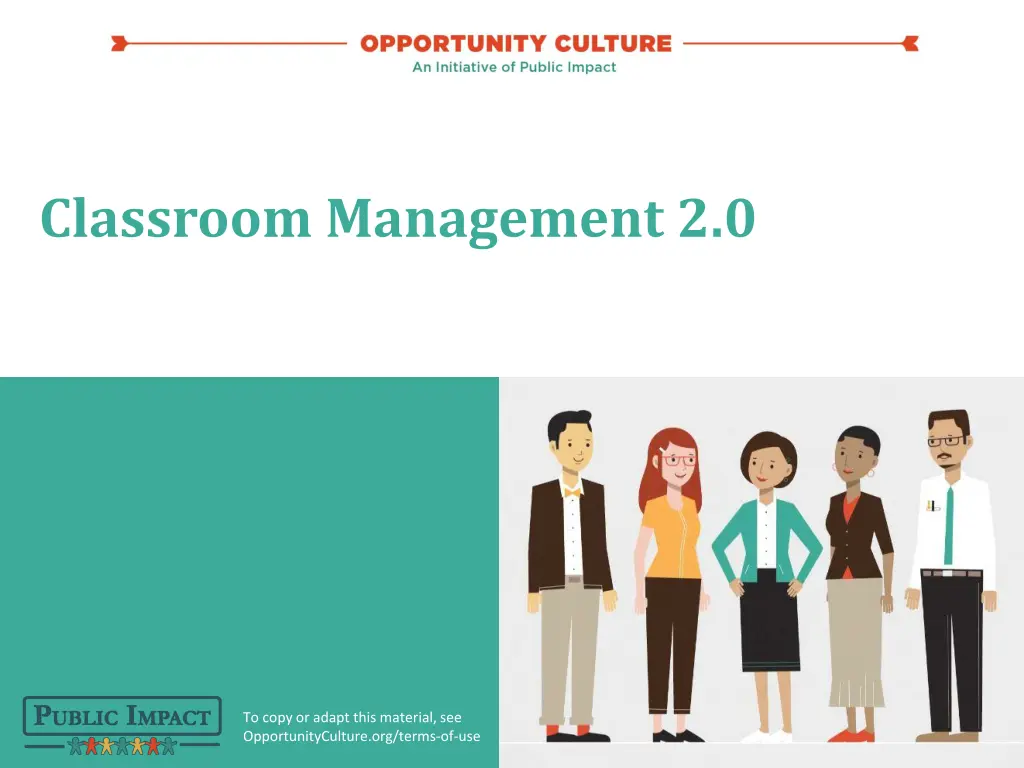
Effective Classroom Management Strategies for Teachers
Explore innovative classroom management techniques, from icebreakers to behavior management cycles, to enhance student engagement and address behavioral challenges. Learn how to de-escalate meltdowns and foster growth mindsets in students for a positive learning environment.
Download Presentation

Please find below an Image/Link to download the presentation.
The content on the website is provided AS IS for your information and personal use only. It may not be sold, licensed, or shared on other websites without obtaining consent from the author. If you encounter any issues during the download, it is possible that the publisher has removed the file from their server.
You are allowed to download the files provided on this website for personal or commercial use, subject to the condition that they are used lawfully. All files are the property of their respective owners.
The content on the website is provided AS IS for your information and personal use only. It may not be sold, licensed, or shared on other websites without obtaining consent from the author.
E N D
Presentation Transcript
Classroom Management 2.0 To copy or adapt this material, see OpportunityCulture.org/terms-of-use 2019 |1
Icebreaker Without talking, form a single file line by birthday (month and day), where January is on the left and December is on the right. Introduce yourself by stating: 1. Name 2. Birthday 3. School and Role 4. What do you hope to get out of this session? 2019 |2
Session Objectives Discuss a behavior management challenge and brainstorm solutions with peers. Practice reacting to a behavior meltdown by encouraging growth mindset development, and managing hot cognition. 2019 |3
Jigsaw: Behavior Management Cycle See Handout 2. Positive Narration 1. Expectations 3. Corrective Action 2019 |4
Behavior Management Cycle Let s all come back together with eyes on me, pencils down, and at a voice level 0. 3. Take corrective action 1. Set and reinforce expectations _______, the expectation was to be at a voice level 0. This is your verbal warning. 2. Use positive narration ________, is at a voice level 0 patiently awaiting directions. 2019 |5
De-escalating Meltdowns See Handout 2019 |6
Why might a student have a meltdown? Fixed Mindset Hot Cognition Image source: https://www.theguardian.com/science/2017/may/31/feeling-anxious-makes-it-harder-to-read-the-emotions-of-others-claims-study 2019 |7
Student Vignette: Jacob Jacob is a student in one of your small groups. Throughout the year, you have noticed that Jacob enjoys participating during Language Arts, Social Studies and Science, but he gets very frustrated during Math class. He often refuses to follow directions in math and gives up if he doesn t know how to do a problem right away. You have overheard him in the past say things like I m stupid! and I ll never be good at math. 2019 |8
Fixed vs. Growth Mindset Source: Dweck, Carol S. (2006). Mindset: The new psychology of success. New York: Ballantine Books. Success of Others Criticism Effort find lessons and inspiration in the success of others learn from criticism see effort as the path to mastery Obstacles persist in the face of setbacks Growth Mindset Challenges embrace challenges Fixed Mindset avoid challenges give up easily see effort as fruitless or worse ignore useful negative feedback feel threatened by the success of others 2019 |9
Strategies to Improve Fixed Mindsets Set achievable, interim goals to encourage consistent, incremental progress. Give frequent formative feedback. Praise effort and strategies, as opposed to intelligence or attainment. Design classroom activities that involve cooperative work. Sources: https://www.edsurge.com/news/2014-10-24-4-ways-to-encourage-a-growth-mindset-in-the-classroom, http://www.sec-ed.co.uk/best-practice/teaching- strategies-to-create-growth-mindsets/, http://www.teachthought.com/learning/cultivate-growth-mindset-classroom/ 2019 |10
Student Vignette: Christina Christina is another student in your class. Throughout the year, you have noticed that Christina has trouble concentrating and following directions when something else is going on at school or at home. For example, earlier this year, Christina s parents separated. When this happened, she didn t turn in her homework, refused to work during your small group, and later that day, she got in a fight with another student. 2019 |11
Hot Cognition Hot cognition is when your emotions affect your thinking, judgment and decisions. For example, a student whose mother was just diagnosed with cancer may make different decisions than when he or she was not in emotional distress. Cold cognition is when you make decisions independent of emotions, often when you are in a calm state. Source : National Research Council. (2015) Measuring Human Capabilities: An Agenda for Basic Research on the Assessment of Individual and Group Performance Potential for Military Accession. Not really a lot of sources out there about hot cognition 2019 |12
Hot Cognition and Trauma Kindergartners who have had tough experiences score below-average in reading and math Those traumatized 5-year-olds also are three times more likely to have problems with paying attention, and two times more likely to show aggression. Source: http://neatoday.org/2016/05/17/trauma-and-children/ 2019 |13
Strategies to Help Manage Hot Cognition Provide Clarity Keep classroom environment neat and uncluttered. Maintain predictable routines. Ask students to repeat verbal instructions. Enable Autonomy Offer a comfort zone to students a safe space where they can calm down. Provide short movement breaks every 30 min to reframe the brain. Develop Skills Provide time and space for students to write about their feelings. Respond to students by naming the emotions they are experiencing. Sources: http://neatoday.org/2016/05/17/trauma-and-children/,https://www.edutopia.org/article/5-ways-help-students-trauma-lori-desautels 2019 |14
Additional Causes for Meltdowns Hot Fixed Mindset Cognition In what ways could fixed mindsets or hot cognition lead to a student meltdown? Image source: https://www.theguardian.com/science/2017/may/31/feeling-anxious-makes-it-harder-to-read-the-emotions-of-others-claims-study 2019 |15
Application 1. With a partner, choose fixed mindset or hot cognition scenario. 2. Individually, read the scenario and transcript. 3. Work with partner to determine the best next steps: What would you say to the student? What else would you do in the moment? What would you do after class? The next day? 4. Debrief full group. 2019 |16
Action Items Write down 2-3 action items you commit to incorporating into your work based on your takeaways from this session. Action Item People Timeline Status Notes 2019 |17
Exit Slip Thanks for your engagement and participation. Please complete the exit slip to provide feedback on this session prior to leaving. 2019 |18
Follow Us! Keep up to date on Opportunity Culture with resources and research from Public Impact by following: @OppCulture @PublicImpact Facebook.com/OpportunityCulture Facebook.com/PublicImpact LinkedIn.com/company/public-impact---chapel-hill-nc Subscribe to the quarterly Opportunity Culture newsletters, with content by and for Opportunity Culture educators, and sign up to get Remind messages for them: Remind.com/join/ocnew OpportunityCulture.org/mailing-list/ 2018 |19
Resources for Additional Learning Growth Mindset Dweck, C. (2006). Mindset: The New Psychology of Success. New York, NY: Ballantine Books https://www.edsurge.com/news/2014-10-24-4-ways-to-encourage-a-growth- mindset-in-the-classroom http://www.sec-ed.co.uk/best-practice/teaching-strategies-to-create-growth- mindsets/ http://www.teachthought.com/learning/cultivate-growth-mindset-classroom/ Hot Cognition and Trauma https://www.edutopia.org/article/5-ways-help-students-trauma-lori-desautels http://neatoday.org/2016/05/17/trauma-and-children/ 2019 |20

